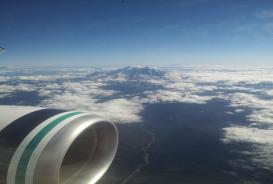
According to a government report, the US is much more vulnerable to volcanic disasters even than Iceland, and yet is failing to monitor the threat as needed.
The government report, issued by the US Geological Survey, sited 169 active volcanoes in the US- almost one third of them classified as ‘serious threats.’ Of those 55 so designated only 3 of them are currently monitored with state-of-the-art instrumentation. Compare that with only 32 active volcanoes in Iceland.
The report states that 39 percent of ‘Very High Threat’ volcanoes are being monitored in a limited, inadequate way. These volcanoes- Mount Rainier in Washington is one example- are being watched for only major changes in their activity levels. The level of monitoring is simply not enough to create detailed models which can satisfactorily predict future behavior.
The report says:
Waiting to deploy a proper monitoring effort until a hazardous volcano awakens and an unrest crisis begins means that scientists, civil authorities, businesses, and citizens are caught in a reactive mode of ‘playing catch up’ with the volcano, trying to get instruments and civil-defense measures in place before the unrest escalates and the situation worsens. Precious time and data are lost in the weeks it can take to deploy a response to a reawakening volcano — time and data that the public needs and should have to prepare for the hazards they may be confronted with.
Geographical regions highlighted by the report include The Cascades of the Pacific Northwest, including Washington, Oregon, California and Nevada. Mount Rainier was singled out as the most threatening volcano in the Cascades range. That is partly because of how close it is to the suburbs of Tacoma and Seattle. Mount St. Helens, which has erupted twice in the past thirty years, is also considered a high priority for monitoring. “Its two eruptive episodes of the past three decades indicate a high probability of renewed eruptive activity.”
Other areas of concern are the Aleutian Islands in Alaska and the Yellowstone super-volcano in Wyoming, which has been the subject of a two part documentary. The USGS stated that:
“If another catastrophic caldera-forming Yellowstone eruption were to occur, it quite likely would alter global weather patterns and have enormous effects on human activity, especially agricultural production, for one-to-two decades.”
Fortunately this scenario is highly unlikely since Yellowstone has not erupted at all for about 70,000 years.
Sorry, comments are closed for this post.